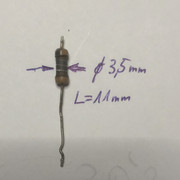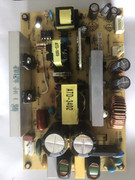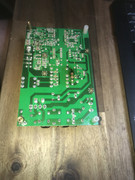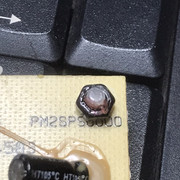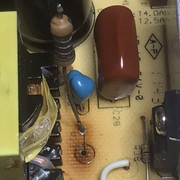|
|
Post by tjmotter on Apr 18, 2019 9:14:48 GMT -5
I haven't found any simple ways of confirming if this device is bad. What I typically do is:
1) check all the voltages. particularly if the board isn't booting properly because this would indicate that whatever device is broken is also bringing a voltage rail down.
2) Since this device ties directly to HDMI ports, I will connect an HDMI source and check the 5V signal for each port to make sure it is working properly. BTW, this is an important once because this 5V signal comes from the source device (like the blueray player) so if it isn't working properly it often indicates that something in the chip is messed up. This won't necessarily manifest itself in any checks of the voltage rails on the HDMI board simply because the voltage is coming in externally but if this external voltage is shorted somewhere in the chip, it will be a problem.
2) if the device is "bootable" (this one is) I will then use an oscilloscope to try to determine if it is fetching code. Since this part (MN864787) has its own firmware chip (Q8402) I will probe the SO pin (pin 2) to see if it is sending data during the startup process. If so, it is probably working but if not, I have to figure out why. Other chips are harder. For example, the HDMI slave (MN864788) will fetch its code from the VSP so you have to pore over the schematics to try to figure out which pin should be receiving the code.
If the chip appears to be booting and doesn't have any obvious shorts on the voltage rails, I assume it is good and keep looking elsewhere in the design. If everything else looks good and I can't find anything else wrong, I will try to go deeper on this part. On some designs I might pull the firmware chip and compare its code to a known good part to see if there is some form of corruption that is stopping the chip from booting properly. In the RZ800 this isn't likely simply because Onkyo built two paths to the firmware. One path allows complete control by the ARM chip and the other allows this chip to update itself. On models like the NR646, Onkyo got cheap and removed the devices that allowed the ARM chip to update the firmware. This was the issue that we fixed on the NR646 post. On those units, I always suspect that the firmware may be bad. My absolute last resort is that if all signs point to this chip being a problem but I just can't narrow it down, I will remove the chip.
HTH
Todd
|
|
|
|
Post by tjmotter on Apr 18, 2019 15:23:07 GMT -5
Making progress.....
Ok, I just received an RZ900 board that was bad. Initial measurements showed that the MAIN CPU Pin 1 (3.3V) was measuring 11 ohms to ground. Clearly this was shorted. I didn't think the CPU was bad so I started tracing backwards and found that Onkyo places a voltage regulator (Q7018) on the backside of the board. This voltage regulator takes a 5V feed and converts it to 3.3V (called +3.3S or +3.3 S in the schematics). This regulator has a diode between the input and the output and when I tested it I saw a dead short. I removed Q7018 and (surprise, surprise), the diode checked out ok. I then went back and measured the resistance between pin 1 of the MAIN CPU and ground and am now seeing about 3K ohm's. Last, after removing Q7018 I connected my firmware reader and was able to successfully capture the program that was sitting on the internal flash of the MAIN CPU. I strongly suspect that if I replace this voltage regulator, the board will boot again. BTW, the RZ900 (and RZ810) is the same part number as the HDMI board in the RZ800.
Can I ask that you check Q7018 on all of your boards and report the resistance measurement between ping 1 and 5? Alternatively, you can do the same thing by measuring across diode D7006. Please report what you find on each of these boards.
If any show a short, remove Q7018 and replace it.
Todd
|
|
|
|
Post by tjmotter on Apr 18, 2019 15:49:33 GMT -5
BTW, since the "Read Protect" isn't set on the RZ900, it will not be set on the RZ800. In fact, I checked the Onkyo firmware site and the installation instructions indicate that the RZ800 and the RZ900 use the same firmware. This is pretty common and what it means is that the program is the same but the MAIN CPU reads the "personality" of the Receiver from Q7001. This also means that I now have a good copy of the RZ800 firmware and can create MICOM's if you need them.....
|
|
|
|
Post by tibimakai on Apr 18, 2019 16:54:25 GMT -5
Thanks for that. I will measure those, when I get home.
The original Micom, on my 800 it was shorted, right?
A coworker, gave me an old Onkyo receiver (HTIB) with speakers and a subwoofer and I'm trying to revive those as well, at the moment.
It was free. No network, no wi-fi, or bluetooth.
HDMI chip is super hot, no output or input at the HDMI section. He installed a fan and heatsink, and was using it as an amplifier.
The sub is blown as well.
|
|
|
|
Post by tjmotter on Apr 18, 2019 17:20:18 GMT -5
Yes, your old Micom was shorted.
You asked about how to check the Panasonic parts. Here is another check you can run. Measure the resistance between the +5V supply and the 3.3V supply. You will recall that the 3.3V supply used the 5V supply for the "ON" pin. When the resistance between these two voltage rails is very low (below 1K ohm) it can point you to areas to check.
I just took another look at an RZ820 board that I bought (the one where the big Panasonic part had a bunch of fried capacitors). The MICOM chip has a hole in the top so I removed it. It is pretty badly blown. The resistance between +5 and +3.3 was only 2 ohms so clearly something was causing this. Removing the MICOM did NOT fix this (although my resistance between 3.3V and ground was now normal). There are only a couple of places where the 3.3V and 5V rails come together. One is on the voltage regulator I pointed you too earlier in this thread. Another is a transistor/diode circuit off the MICOM. A third is on the connection between the MICOM and the MUTE transistors (Q7000-Q7023 - note these are listed as Q700 0 or Q702 3 in the schematics) and the last big one is the Panasonic MN864787 main HDMI controller. In my case, removing the MICOM didn't help and the transistors tested ok so the only thing left was the Panasonic chip. Sure enough, once I removed this chip my resistance jumped up to 5K between the +3.3V and 5V rails. This makes me think that the HDMI (Panasonic MN864787) chip blew first causing the 3.3V rail to dump 5V onto the MAIN MICOM and the Panasonic MN864788 causing those to fail as well. There are other possible explanations but given that the MN864788 is only a slave device and that the MICOM is used in just about every Onkyo built in the past 6 years, the most likely culprit that started this whole mess is the MN864787. FWIW, this device is used for both HDMI outputs which means it is responsible for sending the 5V "hot plug" signal to the TV's connected to it. If a power surge hits the receiver via the TV it is very conceivable it would damage this chip.
HTH
Todd
|
|
|
|
Post by tibimakai on Apr 18, 2019 17:57:21 GMT -5
Do you mean, I have to measure from 3.3V to 5V and not from 3.3V to gnd and 5V to gnd?
|
|
|
|
Post by tjmotter on Apr 18, 2019 18:51:03 GMT -5
you should always test 3.3V to ground and 5V to ground but when looking for potential HDMI chip issues you should also test 3.3V to 5V resistance.
|
|
|
|
Post by tibimakai on Apr 18, 2019 23:00:42 GMT -5
I don't measure short at Q7018, on none of my boards(original board is missing the Micom).
I can't tell you a value, because depends on which way I'm holding the probes, I'm getting a different value, but the value definitely it is in kiloohms(3.7k, or 43k).
There is a short at pin #1 at the Micom, on the 900 board, that I have received from the bay, though. No wonder, that is dead.
The 800 board, that I have received from the bay and I soldered in the Micom, shows 21K at pin #1.
The 900 board shows 1.43 Ohm at pin #1 & #104.
|
|
|
|
Post by tibimakai on Apr 18, 2019 23:03:19 GMT -5
The 800 board has a 3.3VHT+1.1VHT missing issue, not a shorted Micom, at pin #1.
The 900 board, seems like has a short issue, but most likely it is a different issue, than yours.
|
|
|
|
Post by tjmotter on Apr 19, 2019 6:35:59 GMT -5
just to be sure, can you remove Q7018 on the 900 board and then measure the resistance on the MICOM again? It is pretty easy to get off with chipquick. You could use heat instead but there are a lot of parts in this area so chipquick is easier.
|
|
|
|
Post by tibimakai on Apr 19, 2019 9:59:26 GMT -5
I guess, that's the only thing that I can do, other than removing the Micom.
I'm kind of contemplating putting back the Micom, in the original board.
|
|
|
|
Post by tjmotter on Apr 19, 2019 10:27:19 GMT -5
I am concerned that your old board blew the MICOM so it isn't going to get any worse if you move it back. I will create 2 new MICOM's and ship them to you. I would recommend that you focus on fixing the 2nd RZ800 board and/or the R900 board with them. The big question is "what is causing that 1st board to blow MICOM's. I suspect it is going to be one of the HDMI chips. Based on what I saw on the RZ820 board I am suspicious of the MN864787 but I have had numerous issues in the past with the SII9573CTU part used for Q8302. On this note, did I ever ask you to do the measurement tests on the SII part? If it is bad it should exhibit the same low resistance you saw on the NR646 you fixed a couple of months ago. I should add that when I pulled the Panasonic parts off of my RZ820 I found far too little solder for my liking on the two Panasonic parts. That ground lug on the bottom of the chip is designed to dissipate heat by spreading it out on the board. When I pulled this chip I found only 6 tiny spots of solder and am a little concerned. As background, whenever I fix a board I work very hard to try to figure out why the part might have blown. There are 3 different possibilities: 1) some kind of unexpected surge (like lightning)?, 2) did the part simply fail?, 3) is there some type of manufacturing/assembly defect (like the cracked solderball issue)?. In this case one of my working theories is that perhaps Onkyo didn't use enough solder for the Panasonic chips causing them to overheat and blow.
On this note (why did it break?) interestingly, I checked the datasheet for the MICOM and it can pull as much as 50mA. Looking at the RZ800 Service manual, they indicate only 30mA. This might not seem like much of a difference but that Voltage Regulator (S-1333A33) can only handle 100mA. When you total up everything connected to it:
Mute: 12mA MICOM: 30mA (but the spec sheet says 50mA) EEPROM: 30mA plus some smaller stuff (CEC/Reset IC)
Total is 72mA but if you consider that the MICOM's max rating is 50mA, this would jack the current draw up to 92mA before we account for the smaller stuff. This gets pretty close to the maximum rating for the regulator so the question I ask myself is: "did the system fail because this regulator is being driven too hard"?
HTH Todd |
|
|
|
Post by tibimakai on Apr 19, 2019 15:07:15 GMT -5
The second board, has that tiny chip issue. I have ordered some from Digikey, just in case.
We haven't dealt with the SiI chip. Only the other Panasonic chip was replaced, on the original board.
An issue that I have noticed with these Onkyos, that the final transistors are always loose. Just try and tighten them, and you will see that they can be tightened up. I'm wondering if this is the issue, that is causing so many blown amps.
|
|
|
|
Post by tjmotter on Apr 19, 2019 15:38:45 GMT -5
the loose screws won't help, that's for sure! On your original board, have you checked the MUTE transistors I mentioned earlier to see if any of them are shorted? These are the ones on the HDMI board (not the ones you replaced on the AMP board. These suckers tie directly to 5V and could be contributing to the blown MICOM's.
My current working theory is that there are two causes for blown channels:
1) Aging capacitors on the pre-amp side that eventually break down and cause transistor failure on the pre-amp board that cascades down to the main transistors 2) Main transistors that have been worked hard and are starting to degrade causing a BIG mismatch between the PNP/NPN pair that then causes one to work too hard and blow. This could definitely be accelerated by poor heat transfer due to loose screws. If we caught it in time we could adjust this out with the idle adjustment but nobody checks this until it is too late.
HTH Todd |
|
|
|
Post by tjmotter on Apr 19, 2019 15:48:14 GMT -5
The second board, has that tiny chip issue. I have ordered some from Digikey, just in case. We haven't dealt with the SiI chip. Only the other Panasonic chip was replaced, on the original board. An issue that I have noticed with these Onkyos, that the final transistors are always loose. Just try and tighten them, and you will see that they can be tightened up. I'm wondering if this is the issue, that is causing so many blown amps. The only way I could find to get these tiny chips to install was to:
1) mask off the entire area with Kapton tape (because it is going to get REALLY hot) 2) place some flux on the board 2) set the chip in place 3) turn my heat up but my air flow almost as low as possible 4) hold the heat wand (steady) directly above the chip as low as possible but not too low to blow it away
It took a couple of minutes but I eventually got most of the solderballs to bond to the board but the two on one edge didn't stick so I put a little more flux on it, turned the air flow up a bit and angled my wand so that it was applying heat to only the side that wasn't stuck down yet. On my first attempt it blew the chip off and I had to throw it out but on the second try I got a good enough bond on several of the balls to allow me to heat up the other side enough to get those balls to go molten and stick. ROYAL PITA!!!
BTW, I should add that this did NOT fix my problem (which made me REALLY mad). These chips have some kind of short detection in them and it wasn't turning on because one of the HDMI chips was blown. Once I replaced that chip (I forget which one) the board fired right up.
In retrospect, what I should have done was to simply use a piece of wire to bridge from the input side to the output side to see if the board worked. That device merely acts as an on/off switch so this might have caused me to blow something up on 3.3V side but that would have been MUCH easier to fix.
Good luck! Todd
|
|


